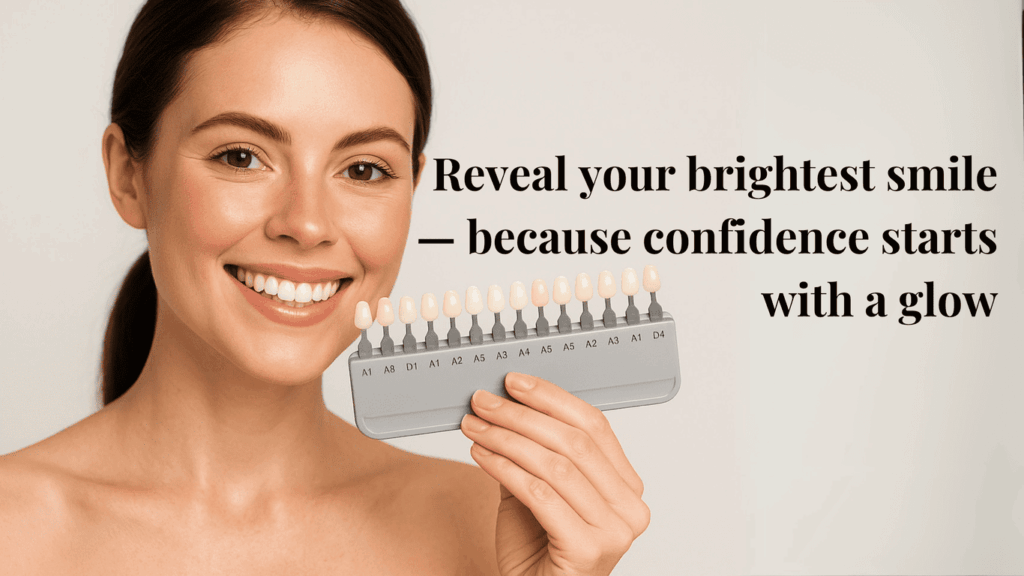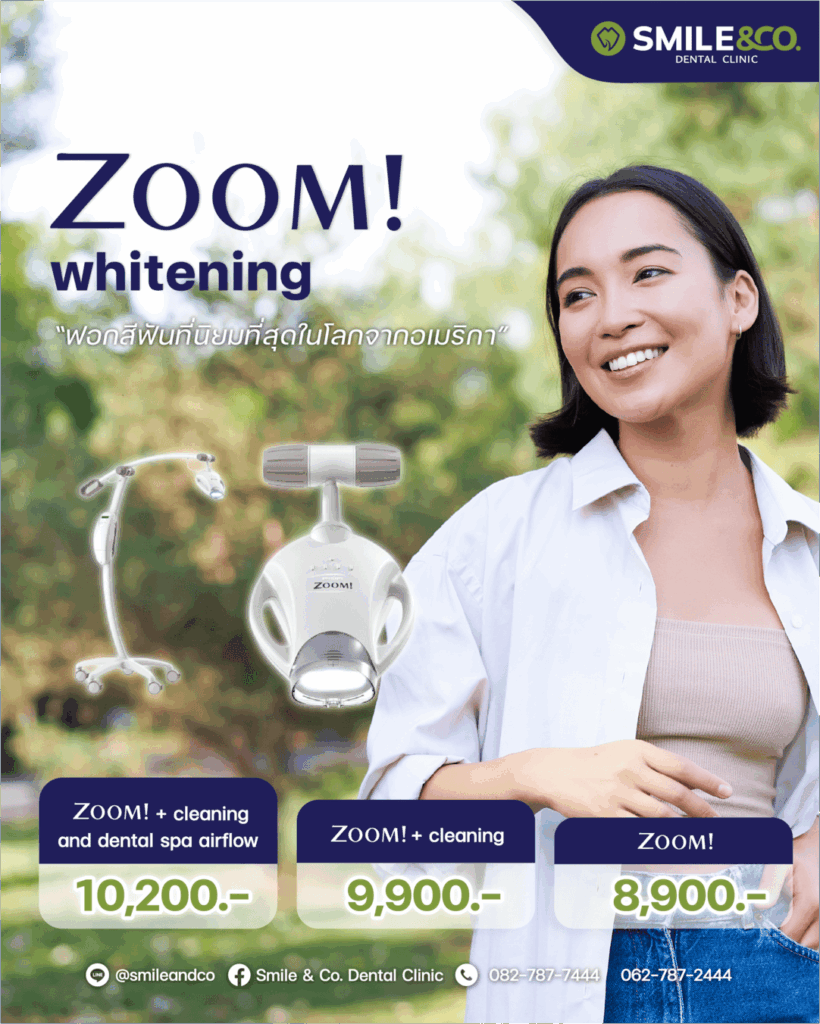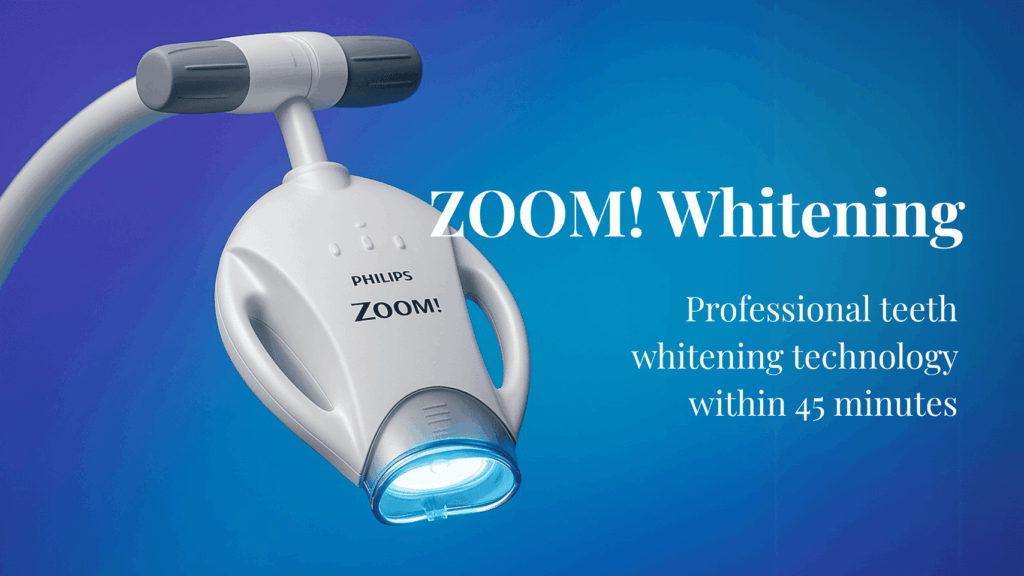
What Is Teeth Whitening?
Teeth whitening is a cosmetic dental procedure designed to restore the natural whiteness of teeth that have become discolored, yellowed, or uneven in tone. The treatment involves the application of a high-concentration whitening gel that penetrates the enamel and works to break down and remove intrinsic and extrinsic stains within the tooth structure.
The effectiveness of teeth whitening varies among individuals and depends on two primary factors:
- Extrinsic factors, such as smoking, consumption of coffee, tea, red wine, and highly pigmented foods
- Intrinsic factors, such as pigmentation accumulated during tooth development or internal discoloration from non-vital (dead) teeth
The whitening process is carefully administered by a qualified dental professional who selects the appropriate concentration and method based on the condition of your teeth. This ensures visible whitening results while maintaining the integrity and health of the enamel.
Everything You Need to Know About Zoom! Whitening

What is Zoom! Whitening?
Zoom! Whitening is an advanced in-office teeth whitening treatment developed in the United States. It is designed to whiten teeth quickly and effectively, often within just 45 to 60 minutes. This procedure is ideal for individuals seeking immediate, visible results.
How does Zoom! Whitening work?
Zoom! Whitening uses a specially formulated hydrogen peroxide gel activated by a proprietary LED light. The light enhances the gel’s effectiveness, allowing it to penetrate deep into the enamel to break up and remove stains caused by coffee, tea, red wine, tobacco, and aging—without harming the tooth structure.
Benefits of Zoom! Whitening
- Fast procedure (45–60 minutes)
- Immediate and visible results
- Safe and non-invasive
- Long-lasting with proper maintenance
- Protective barriers used to safeguard gums and oral tissues
Who is an ideal candidate for Zoom! Whitening?
- Individuals seeking quick cosmetic enhancement
- Those with staining from coffee, tea, wine, or smoking
- Patients with age-related or dietary tooth discoloration
- Candidates with generally healthy gums and no severe decay
Precautions and preparation before the procedure
- Professional cleaning (scaling) and oral health assessment are recommended prior to treatment
- Any cavities or gum issues should be treated beforehand
- Temporary tooth sensitivity may occur post-treatment
Post-treatment care recommendations
- Avoid deeply pigmented foods and beverages (e.g., coffee, tea, soda, red wine) for at least 48 hours
- Refrain from smoking immediately after treatment
- Maintain excellent oral hygiene practices to prolong results
Who is Teeth Whitening Suitable For?
Teeth whitening is an aesthetic dental procedure ideal for individuals experiencing discoloration, yellowing, or dullness of the natural tooth shade. It is especially beneficial for those who place a high value on their appearance and wish to enhance their confidence through a radiant smile. The procedure is particularly suitable for:
- Professionals in client-facing roles — Individuals who frequently engage in interpersonal communication, such as those in sales, management, or service industries, where a confident smile plays a crucial role.
- Habitual tea, coffee, or alcohol consumers — These beverages are among the most common contributors to surface stains and tooth discoloration.
- Heavy smokers — Nicotine and tar can deeply stain teeth, often resulting in persistent discoloration that is difficult to remove through regular brushing.
- Individuals with intrinsic staining from antibiotics — Particularly those who were exposed to tetracycline antibiotics during early tooth development, which may cause long-term internal discoloration.
- Individuals with naturally discolored or stained teeth Those whose teeth have yellowed or darkened due to dietary habits, tobacco use, or natural aging. Stains from coffee, tea, wine, and smoking are among the most common reasons for tooth discoloration.
- Patients affected by intrinsic tooth discoloration Especially those who took certain antibiotics like tetracycline during tooth development, which can result in deep, long-lasting staining of the dentin layer.
- Individuals preparing for a special occasion Such as weddings, pre-wedding photoshoots, important job interviews, or public speaking events, where a brilliant smile contributes significantly to one’s confidence and presence.
Teeth whitening is a safe and effective solution for restoring the natural radiance of your smile—often in just a single session.
Does Teeth Whitening Really Work? How White Can Your Teeth Get?
Yes, professional teeth whitening treatments are clinically proven to significantly brighten the appearance of teeth. The degree of whitening and the longevity of results—typically lasting between 6 months to 1 year—depend on several factors, including:
- The initial shade of the patient’s teeth
- The type and concentration of whitening gel used
- The effectiveness of the whitening equipment
- Oral care habits such as diet, smoking, and consumption of staining beverages like coffee, tea, or red wine
With proper post-treatment care, the effects of teeth whitening can be extended and maintained over time.
For individuals seeking an immediate and customizable aesthetic result, dental veneers (porcelain laminates) offer an alternative solution. Veneers are ultra-thin ceramic shells custom-designed to bond to the front surface of the teeth, instantly improving tooth color, shape, and overall appearance. They also allow for personalized shade selection, achieving a naturally beautiful and brighter smile.

How Much Whiter Can Teeth Get After Whitening?
Teeth whitening typically results in an improvement of approximately 3 to 5 shades on the dental shade scale. However, the final outcome can vary depending on individual factors such as:
- The original color of the teeth prior to treatment
- The tooth’s responsiveness to the whitening agent
- The internal structure and condition of the enamel and dentin
Prior to the procedure, the dentist will use a professional shade guide to demonstrate the current and projected shades, allowing patients to visualize the expected level of whitening and assess the results post-treatment.
Choosing a dental clinic equipped with advanced technology and experienced professionals ensures that whitening treatments are not only effective, but also safe and tailored to deliver optimal aesthetic results.
Types of Teeth Whitening Treatments
Teeth whitening is an increasingly popular aesthetic dental procedure, offering a variety of methods tailored to individual dental conditions, causes of discoloration, and lifestyle preferences. Below are the five primary categories of whitening treatments:
1. In-office Power Bleaching
This professional-grade whitening is performed at the dental clinic using a high-concentration bleaching agent, often activated by light sources such as lasers. It is one of the most effective and safest options, delivering immediate results under the supervision of a qualified dentist.
2. At-home Bleaching
This method involves custom-made whitening trays prepared by a dentist following an initial consultation. Patients then continue the treatment at home using dentist-prescribed whitening gels. It is more affordable and convenient, though it requires consistency and a longer duration to see noticeable results.
3. In-office Assisted Bleaching
Ideal for individuals with deeply discolored teeth, this hybrid approach combines initial in-clinic whitening with continued home treatment. The dentist performs the first bleaching session and provides materials for the patient to maintain and enhance the outcome at home.
4. Over-the-counter Bleaching
Whitening products such as strips, whitening toothpaste, and rinses can be purchased at pharmacies or retail stores. While these are accessible and convenient, their effectiveness and safety are generally lower than professional treatments.
5. Internal Bleaching
Reserved for non-vital (dead) teeth that have darkened due to internal staining, this method is performed exclusively by dentists. The procedure involves placing a bleaching agent inside the tooth to restore its color without affecting adjacent teeth.
Which whitening method is right for you?
Selecting the most suitable teeth whitening method should be based on a professional dental evaluation to ensure safety, efficacy, and long-lasting aesthetic results tailored to your individual needs.
In-office Tooth Bleaching: Techniques and Their Differences
In-office tooth bleaching is a highly effective and safe method for achieving a whiter, brighter smile—performed under professional dental supervision. There are three primary techniques commonly used in modern dental practices:
1. Cool Light LED Whitening
This technique involves the application of a high-concentration bleaching gel on the tooth surface, followed by exposure to a gentle LED light. The light activates the gel, allowing oxygen molecules to penetrate the enamel and break down discolored pigments. It is ideal for patients seeking immediate yet natural-looking whitening results.
2. Laser Teeth Whitening
Using diode laser technology, this method enhances the performance of the bleaching agent by increasing its penetration into the tooth surface. It is particularly effective in eliminating deep-seated stains and is often recommended for individuals with stubborn discoloration.

3. Zoom! Whitening
Zoom! Whitening utilizes an advanced, high-intensity blue light to accelerate the action of the whitening gel. The active ingredients penetrate deeply into the enamel, lifting intrinsic stains without compromising the structural integrity of the tooth. This technique delivers dramatic, immediate results.
At Our Clinic
We proudly offer both Cool Light LED Whitening and Zoom! Whitening services.
Cool Light LED is a time-efficient and cost-effective solution, typically completed within 30 to 45 minutes, while Zoom! Whitening is ideal for those who desire more pronounced, longer-lasting whitening effects.
Our dentists will provide personalized assessments and professional guidance to ensure you receive the safest and most effective treatment tailored to your unique dental condition.
Step-by-Step Guide to Professional Teeth Whitening
In-office teeth whitening is a safe and effective procedure performed under the supervision of a dental professional. The process is methodical and carefully controlled to ensure optimal results and minimal sensitivity. Below is a detailed breakdown of each step:
- Comprehensive Oral Examination The dentist will first assess the condition of your teeth and gums to determine if whitening is appropriate. Any issues such as cavities, gum disease, or enamel erosion must be addressed prior to treatment.
- Shade Assessment and Pre-treatment Photography Baseline photographs are taken, and the current tooth shade is evaluated using a standardized shade guide. This allows for objective comparison before and after treatment.
- Soft Tissue Protection A cheek retractor is used to expose the teeth, and a gingival barrier gel is applied to protect the gums and surrounding soft tissues from the whitening agent.
- Application of Whitening Gel and Light Activation A high-concentration whitening gel is carefully applied to the surface of the teeth. Depending on the method chosen (e.g., LED Cool Light or Zoom! Whitening), a specialized light is used to activate the gel and accelerate the whitening process.
- Multiple Treatment Cycles The whitening gel may be reapplied 2 to 3 times during the session, with each cycle lasting approximately 15 minutes. The number of cycles depends on the severity of the staining and the patient’s sensitivity.
- Final Rinse and Shade Comparison After the final cycle, the whitening gel is thoroughly rinsed off, and the tooth shade is reassessed using the shade guide to measure the level of improvement.
- Post-treatment Care Instructions Patients are advised to avoid staining foods and beverages—such as coffee, tea, red wine, and curry—for at least 48 hours. This helps preserve the brightness of the results for as long as possible.
Teeth Whitening Prices at SMILE & CO. Dental Clinic
At SMILE & CO. Dental clinic, we offer a range of professional teeth whitening services tailored to your lifestyle and aesthetic goals. Whether you’re seeking immediate results in-office or prefer the flexibility of at-home treatment, we provide safe and clinically effective options.
Teeth Whitening Price Table
| Whitening Treatment Type | Price (THB) |
| Zoom Whitening | 8,900 |
| Zoom Whitening + Scaling | 9,900 |
| Zoom Whitening + Scaling + Dental Spa Airflow | 10,200 |
| Cool Light LED Whitening | 3,950 |
| Cool Light LED Whitening + Scaling | 4,500 |
| Cool Light LED Whitening + Scaling + Dental Spa Airflow | 4,800 |
| At-home Whitening Kit (Custom tray + 1 Opalescence syringe) | 4,000 |
Note: Prices are per session and may vary based on ongoing promotions. Please contact the clinic directly for the most up-to-date information and personalized consultation.
Post-Whitening Sensations: What to Expect in Detail
Following a professional teeth whitening session, patients may experience certain transient side effects, which are generally mild and self-limiting. Understanding these sensations helps set realistic expectations and ensures a smoother recovery process.
Common post-whitening symptoms include:
- Temporary Tooth Sensitivity The most frequently reported side effect, often due to the bleaching agent penetrating the enamel and affecting the dentin layer. Sensitivity typically lasts 1–3 days and resolves without intervention.
- Minor Gum Irritation If the whitening gel inadvertently comes into contact with the gingiva, some patients may experience mild redness or a stinging sensation. This usually subsides within a few days and is minimized by proper isolation techniques during the procedure.
- Thermal Sensitivity Sensitivity to hot or cold foods and beverages may occur temporarily. It is recommended to consume foods and drinks at room temperature for 48–72 hours post-treatment.
Post-treatment care recommendations:
- Avoid dark-colored foods and beverages such as coffee, tea, red wine, soda, and curry for at least 48 hours
- Refrain from smoking or using tobacco products
- Use toothpaste formulated for sensitive teeth and rinse with water after meals
If symptoms persist beyond 3–5 days, it is advisable to consult your dentist for further evaluation and care
Post-Whitening Care: How to Maintain Whiter Teeth for Longer
Proper oral care following a professional teeth whitening procedure is essential for maintaining results and prolonging the brightness of your smile. By adopting mindful habits and avoiding common staining factors, patients can extend the longevity of whitening effects for several months—or even longer.
Recommended Post-Whitening Guidelines:
- Avoid dark-colored foods and beverages for the first 48 hours
This includes coffee, tea, red wine, cola, curry, soy sauce, and any highly pigmented foods. During this time, your enamel is more porous and susceptible to staining. - Refrain from smoking or using tobacco products
Nicotine and tar are major contributors to discoloration. Abstaining for at least 48 hours post-treatment is highly recommended. - Use a straw when consuming pigmented beverages (if unavoidable)
This minimizes direct contact with the front teeth and reduces the risk of staining. - Brush at least twice daily with whitening or sensitivity-friendly toothpaste
Floss daily to remove interproximal plaque and food particles that can contribute to staining. - Schedule regular dental checkups every 6 months
Professional cleanings and examinations help maintain oral hygiene and preserve the aesthetic outcomes of whitening treatments.
With consistent care and appropriate lifestyle modifications, whitening results can last anywhere from 6 to 12 months or more—depending on individual habits and oral health.
Who Should Avoid Teeth Whitening?
While teeth whitening is generally a safe and effective cosmetic dental procedure, it is not suitable for everyone. Certain individuals may be advised to postpone or avoid treatment altogether, depending on their oral and general health status. These include:
- Pregnant or breastfeeding women Due to limited clinical data regarding the safety of whitening agents during pregnancy or lactation, it is recommended to delay the procedure during these periods.
- Children under the age of 16 The pulp chamber of the tooth is still developing, making younger individuals more susceptible to irritation or potential damage from whitening agents.
- Patients with periodontal disease or gum inflammation Whitening can exacerbate existing soft tissue conditions and should be avoided until the condition is stabilized.
- Individuals with dental hypersensitivity, untreated cavities, or dental restorations Whitening may intensify sensitivity or be less effective on restored teeth. A comprehensive dental examination is essential prior to treatment.
- Those with other oral health issues Such as enamel erosion, non-vital (dead) teeth, or intrinsic discoloration due to medication. These cases require specialized evaluation before proceeding with whitening.
If you are uncertain whether you are a candidate for teeth whitening, consult with your dental professional to ensure the procedure is appropriate and safe for your specific needs.
How to Whiten Teeth Safely?
For safe and effective teeth whitening, it is highly recommended to undergo the procedure under the supervision of a licensed and qualified dental professional. Whitening treatments involve chemical agents that interact directly with dental tissues, and therefore require professional assessment and technique.
Although over-the-counter or online whitening products may seem convenient and affordable, they carry significant risks when used without professional guidance, including:
- Increased tooth sensitivity
- Gum irritation or inflammation
- Enamel erosion
- Potential damage to the dental pulp
To ensure both safety and long-term success, professional evaluation is crucial. A dentist can assess the health of your teeth and gums, recommend the most suitable whitening method, and monitor the procedure to minimize risks while optimizing results.
Whitening your teeth may enhance your confidence—but doing so under professional care will protect your smile for the long run.
Frequently Asked Questions About Teeth Whitening (Professional FAQ)
If you’re considering teeth whitening but have a few questions in mind, you’re not alone. Below are expert responses to some of the most common inquiries patients have prior to undergoing the procedure:
Can I whiten my teeth while wearing braces?
No. Whitening treatments are not recommended during orthodontic treatment, as the brackets cover portions of the tooth surface, leading to uneven whitening. It is best to wait 3–6 months after removing braces before undergoing whitening.
How many sessions are needed?
A single session often yields visible improvement. However, the degree of whitening varies based on the original shade of your teeth and individual tooth anatomy.
How long does the treatment take?
In-office whitening typically takes 30–45 minutes, depending on the method and technology used.
Will whitening damage my enamel?
No. When professionally administered, the whitening agents act on internal pigments within the tooth structure and do not erode or thin the enamel.
Is the procedure painful?
The procedure is not painful. However, some patients may experience temporary tooth sensitivity during or after the treatment, which usually subsides within 24–48 hours.
How long do results last?
Results generally last between 6 to 12 months, depending on oral hygiene, dietary habits, and lifestyle choices such as smoking.
- How often can I repeat the procedure? Whitening can be repeated every 6–12 months, but always under professional supervision.
- Can I whiten teeth with fillings or crowns? No. Restorations like crowns or composite fillings do not respond to whitening agents. Replacement may be needed to match the newly whitened teeth.
How to Choose a Trusted Whitening Clinic?
Opt for a licensed dental clinic with certified professionals, sterile equipment, reputable whitening systems, and transparent patient reviews. A well-qualified dentist will not only ensure aesthetic results but also protect your long-term oral health.

 TH
TH


